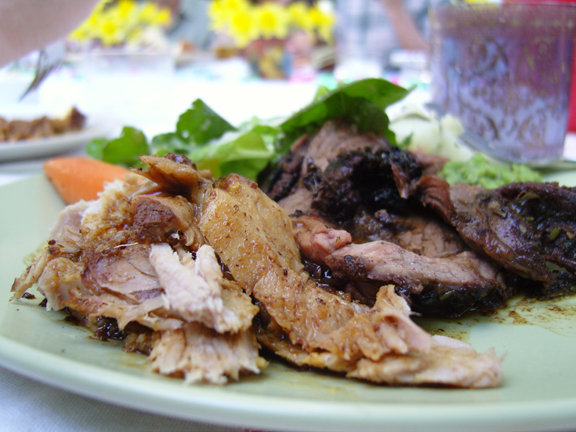
Slacking again. Been on the road another long spell for work. Despite that, I still owe you these recipes from my Easter post. Pickled Eggs pickled in two variations, sweet and spicy.
My mother made beet pickled eggs for Easter as far back as I can remember. They were a good gateway device to introducing a kid to beets. Beyond those eggs, I had no idea what a beet even was. I'm sure I threw away the yolks and concentrated on the vinegar sweet purple-stained whites. I wouldn't do that now, but I can say that I watched a friend at our Easter dinner put down six eggs in about 4 minutes sans yolks. His excuse was "cholesterol". It was a sad sight. Six lonely yolks sitting on a plate, wasted. My Pickled Beets with Red Eggs is an evolving recipe. I based it on a combination of recipes, mostly traditional Amish versions. I've tweaked it here and there over the years and I'm happy with it's current state.
My Pickled beets with red eggs
9 beets
water to cover
1 cup cider vinegar - Ha's Apple Farm Vinegar (my local apple grower)
1 cup cold water
1/2 cup brown sugar, firmly packed
1 tsp salt
1.5 stick cinnamon
7 cloves
10 whole peppercorns
1/4 tsp ground mustard - Colman's
16 hard-boiled eggs - peeled
cook beets on high for 12 mins. Let stand. Make sauce. Mix all together. Drain beets. Slip off skins. Pour sauce over beets. Cover. Cook on high for 8 mins. Let stand several days. Add eggs to sauce and some beets. Let pickle for at least 2 days in the refrigerator. Store in the refrigerator as well.

The spicy pepper eggs are my version of Joe Jost's pickled eggs. Joe Jost's is a great old family -owned tavern in Long Beach, California. The bar has a separate pool hall in back with pool tables, snooker tables, and a shuffle board. Foodwise, you can get amazingly simple, yet super delicious sandwiches at the bar. I rotate through three of the sandwiches: Joe's Special, Liverwurst (2 inches thick) with Red Onions and mustard, or Thick sliced Salami (thick means THICK) with cheese. Joe's Special consists of two split Polish Sausages (basically, hot dogs) with a pickle spear, swiss cheese and mustard on rye. This would be my proper set-up for a bit of relaxing at Joe's while watching a game: a Joe's Special, a Schooner of beer (Sierra Nevada), two pickled eggs (or more), and some fresh roasted peanuts. The pickled eggs are served with some yellow pickled peppers on top of a handful of skinny pretzel sticks, wet with the pickling juice. Delicious.
My eggs are pretty close to the real thing. Actually, they're probably better, but of course they lack a certain je ne sais quoi that you won't get unless you're at Joe's. After all, Joe's claims to have sold 6,000,000 of the eggs since 1934. More on Joe Jost's here.
My Joe Jost style Pickled Eggs
2 16oz jars hot yellow chili peppers with juice
3tbsp Pickling Spice
2 cups distilled vinegar
2 cups water
1.5 tbsp Sugar
1.5 tsp Turmeric
2.5 tsp Salt
5 Serrano, Jalapeno, or Habanero (your choice) chiles blistered, peeled & chopped – with seeds
3 cloves garlic chopped
20 hard-boiled eggs - peeled
Combine all the ingredients and mix well in a large sanitized jar that can be sealed. Add the peeled hard-boiled eggs when they're still hot. Let pickle in the sealed jar in a cool dark place for at least 5 days for best flavor. The longer the better.
















